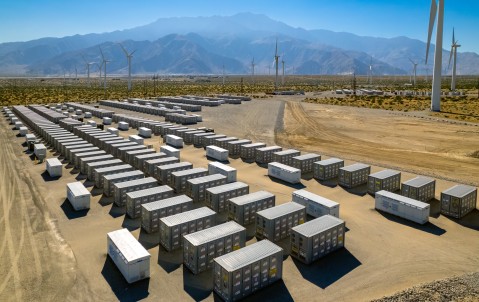
Powering up: grid scale battery energy storage systems (BESS) to bridge the renewables gap
In the drive to decarbonise the world’s power generation and meet net zero commitments, the use of batteries to bridge the inherent unpredictability of renewables, such as wind and solar, is expanding rapidly. A recent announcement naming Scotland as the future home to the three largest battery energy storage systems (BESS) in Europe, capable of providing electricity to 4.5 million homes for a two hour period, is just one indication of how battery energy storage systems (BESS) are expected to grow.
“Electric utility companies are increasingly turning to BESS projects to add flexibility to electricity grids, presenting the insurance industry with a big opportunity to support this fast-paced growth,” says Hiscox’s Louis Cozon, Power and Renewables Line Underwriter. “But what’s also fast is the development of the battery technology used, which means we must tap into the different engineering skills needed to understand and underwrite the risks involved.”
Energy storage must grow
According to the International Energy Agency, “Grid-scale battery storage needs to grow significantly to get on track with net zero targets,” while also observing that “to triple global renewable energy capacity by 2030…energy storage needs to increase six-times.” And it seems development, at the current rate, is not too far away from that target according to a recent report forecasting a fivefold increase in BESS capacity by 2030. But why the urgent need for energy storage?
Renewable energy sources like wind and solar do not provide the same predictable generation of energy compared to more traditional non-renewable energy sources like gas and coal. This means energy storage is needed when there is a mismatch in energy demand and supply. “When there is an excess of energy generated from renewable energy assets, that excess energy can be used to charge the BESS units. Conversely, when demand exceeds generation, BESS units can then discharge energy to the electricity grid.” says Hiscox’s Martin Joseph, Power Generation Engineer.
Battery technology evolves at speed
BESS projects offer significant potential but it’s important to recognise that one of the challenges around BESS is how quickly battery technology has evolved over the years. “It’s a story of rapid development in the last decade,” says Joseph. “Lithium-ion has been the dominant type of battery used in BESS and this can be further split into two main types: nickel manganese cobalt (NMC) and lithium iron phosphate (LFP). While NMC was once the most common type used in BESS projects due to its higher energy density, there has been a shift towards LFP for various reasons including lower cost and its higher cycle life. Safety is also a factor as LFP batteries are seen as more ‘stable’ when it comes to the onset of thermal runaway events which can cause fires in the BESS units.”
While lithium-ion LFP now accounts for a majority of BESS installations globally, adds Joseph, the development of battery technology might not stop there, with the exploration of sodium-ion as a possible alternative. Chinese motor company BYD has already announced one of the world’s first ‘grid-scale’ BESS products using sodium-ion technology, which takes advantage of the greater abundance of sodium, when compared to critical minerals such as lithium. Other benefits of sodium-ion technology include “a higher charge/discharge rate, a broader operating temperature range, a longer cycle life, and improved safety” according to BYD. However, sodium-ion technology remains in the very early stages of commercial deployment, with only a handful of pilot installations currently in operation. On top of that, due to its typically lower energy density and other performance constraints, it is more likely to complement lithium-ion BESS rather than replace it in the near future.
The insurable challenge
While exciting, the fast-paced change in terms of the growth of BESS projects and the technology that underpins them presents a challenge to the insurers who support their construction and operation. Throughout the BESS project lifecycle, there are different risk challenges that demand specialist insurance products, requiring a different set of underwriting skills and knowledge. “We’ve worked hard to ensure we’re able to offer the full range of products to meet our clients’ needs; from construction and installation, delay in start-up coverage through to the operational coverages required from a physical damage, business interruption and liability perspective,” says Cozon. But critical to the provision of this insurance is the ability to understand the changing technology. “At Hiscox, we believe having experienced risk engineers in-house enables us, as underwriters, to understand the changing risk profile. It’s this deep understanding that enables us to be one of the market leaders in the provision of insurance for BESS projects,” Cozon adds.
Safely managing a BESS risk
For a well-managed BESS risk, insurers look for several attributes. “Natural catastrophe risk is an obvious potential threat as it would be for any power generating or power storage infrastructure. We want to understand if there is exposure to flood, high winds or any other natural risk such as earthquake and specifically, whether the BESS project is built to withstand these risks,” explains Cozon.
Spacing between BESS units is an important consideration. Adequate spacing can mitigate the spread of fire in the event of a thermal runaway event and NFPA855, a standard covering the installation of energy storage systems (ESS), provides guidance on the separation required for BESS units. “It is important to note that, there can be a variation in behavior between different BESS unit models during a thermal runaway event depending on their design and manufacture. To effectively manage this variation, standardised testing plays a critical role. One of the ways this is done is through UL9540, a system level ESS safety standard” explains Joseph. “As part of this standard, UL9540a is a companion test method specifically for BESS that analyses the behaviour of BESS units at various levels during a forced thermal runaway event. The results from this test can then be used to inform the spacing and safety design of the model of BESS unit that has undergone the testing.”
Another consideration in BESS safety is the battery management system (BMS) – this is the system that monitors the BESS unit to ensure that certain parameters such as current, voltage and temperatures do not fall out of normal operating ranges. If any of these values reach unsafe levels, the BMS can activate an alarm or even electrically isolate the affected BESS unit meaning the BMS plays an important role in the safe operation of BESS projects. This is also another area that is undergoing development with the use of AI and machine learning to analyse the long term trends from the BMS data,” says Joseph, “This can help to flag conditions before they become critical. This information can then be used, for example, to replace components that are not functioning correctly and before they allow a more serious issue to develop.
Capacity is available
Given these parameters, insurers’ appetite for BESS risks continues to evolve, with underwriters fine tuning their appetite following some notable market events. “The increasing number of BESS projects is fueling demand for insurance, in line with the huge investment in renewables and the energy storage needed for grid stability,” says Cozon. “For high quality risks underwritten by a strong market lead there is sufficient insurance capacity, with the London market stepping up to support this increased demand. At Hiscox, we see BESS projects as an exciting growth area. But we recognise the importance of engineering insight so we can deliver the long-term support needed for both the construction and the operation of BESS projects as they play their part in the energy transition.





